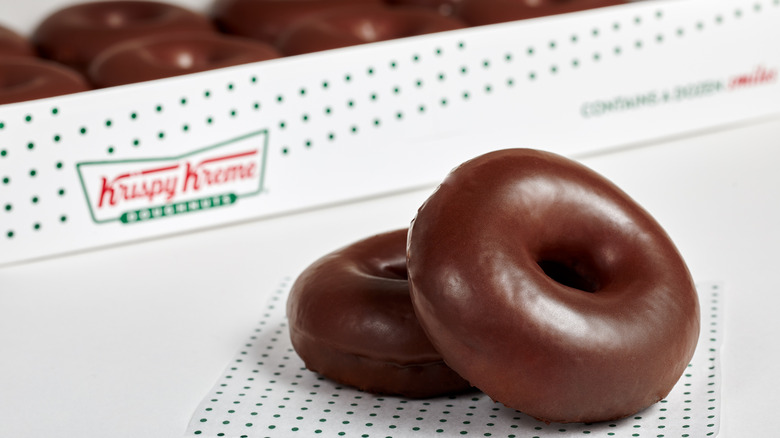What Oil Does Krispy Kreme Use

The aroma of glazed doughnuts, a siren song for sweet-toothed individuals, often leads directly to the doors of Krispy Kreme. But behind that iconic glaze and fluffy dough lies a crucial ingredient that often goes unacknowledged: the oil. The specific type of oil used in the frying process significantly impacts the final product's taste, texture, and nutritional profile. This seemingly simple choice sparks debate among health-conscious consumers and industry insiders alike.
Understanding what kind of oil Krispy Kreme uses is not merely a matter of satisfying curiosity. It directly addresses concerns about saturated fat intake, potential health impacts, and the company's commitment to transparency and evolving consumer preferences. This article delves into the specifics of Krispy Kreme's frying oil, drawing on official statements, nutritional information, and industry insights to provide a comprehensive overview. We aim to present a balanced perspective on the brand's oil choices. Furthermore, this will cover implications for health, sustainability, and the future of doughnut production.
The Oil in Question: What Krispy Kreme Officially States
Krispy Kreme's official stance on its frying oil is generally consistent across its nutritional information and public statements. The company acknowledges using a vegetable shortening. This shortening is primarily composed of soybean oil.
Soybean oil is a widely used and relatively inexpensive vegetable oil. It is derived from soybeans, a legume crop cultivated globally. The company also highlights the use of fully hydrogenated cottonseed oil in their product, though its specific purpose is not detailed.
Decoding Soybean Oil: Composition and Characteristics
Soybean oil is composed of a mix of fatty acids, including saturated, monounsaturated, and polyunsaturated fats. The percentage of each fatty acid can vary depending on the processing and source of the soybeans. Generally, it has a relatively high proportion of polyunsaturated fats, like omega-6 fatty acids.
Fully hydrogenated cottonseed oil goes through the process of hydrogenation. This increases its saturated fat content and its stability during frying. It's used in different parts of the doughnut making process.
Health Implications: Saturated Fats and Beyond
The presence of saturated fats, particularly from hydrogenated cottonseed oil, raises some health concerns. Diets high in saturated fats can contribute to increased LDL cholesterol levels. This increase may lead to a higher risk of cardiovascular diseases, according to numerous studies.
However, the amount of saturated fat per doughnut needs to be considered in the context of an overall diet. Consuming doughnuts in moderation might not pose a significant health risk for most individuals. Individuals with pre-existing health conditions should be more cautious about saturated fat intake.
Krispy Kreme's Response and Commitment to Innovation
Krispy Kreme has faced increasing pressure to address concerns about the healthfulness of its products. The company has responded with efforts towards transparency by providing nutritional information readily available to consumers. This allows informed choices.
It's worth noting that the food industry as a whole is constantly exploring alternative oils. These alternatives are typically with healthier profiles, such as high-oleic sunflower oil or canola oil. These can offer similar frying characteristics with a lower saturated fat content.
Consumer Demand for Healthier Options
The market trend clearly indicates a growing demand for healthier food options. This pressure encourages companies like Krispy Kreme to consider alternatives. These can reduce saturated fat and potential harmful trans fats.
Some doughnut shops are already experimenting with healthier frying oils and ingredients. These shops are highlighting the commitment to health-conscious consumers.
The Future of Frying: Sustainability and Innovation
Beyond health considerations, the sustainability of oil production is also becoming an increasingly important factor. Soybean cultivation, while widespread, can have environmental impacts related to deforestation and pesticide use. This is a valid concern.
Exploring alternative, more sustainable oil sources is crucial for the long-term viability of the food industry. This exploration should include innovative agricultural practices.
"The doughnut industry, like all food production, is facing a turning point. Consumers want both indulgence and responsibility, demanding transparency and healthier options without sacrificing taste." - Industry Analyst, Food Trends Monthly
Krispy Kreme, as a leading brand, has the potential to drive positive change by embracing sustainable sourcing and innovative frying techniques. The adoption of new methods should be considered.
Conclusion: Balancing Indulgence with Responsibility
Krispy Kreme's current use of soybean oil and hydrogenated cottonseed oil presents a complex picture. It highlights the challenges of balancing cost-effectiveness, flavor, texture, and health considerations in the food industry. As consumer awareness of nutrition and sustainability continues to grow, Krispy Kreme and other doughnut producers will face increasing pressure to adapt.
The future of doughnut production likely involves a combination of factors: continued research into healthier and more sustainable oil options, transparent labeling, and a commitment to responsible sourcing. While the lure of the original glazed will always be strong, Krispy Kreme's long-term success may depend on its ability to evolve and meet the changing demands of its customers and the planet. The future of the doughnut hangs in the balance of conscious decisions.









:max_bytes(150000):strip_icc():focal(816x572:818x574)/krispy-kreme-hersheys-donuts-031725-2-d9199c55b8df4349ac945ae622a41e83.jpg)
:max_bytes(150000):strip_icc():focal(749x0:751x2)/Krispy-Kreme-082024-aaa0dfa7cc9c48768740a139de4f40ae.jpg)







